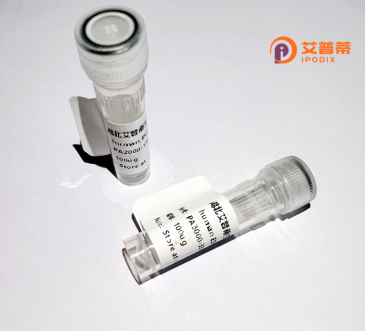
| 纯度 | >90%SDS-PAGE. |
| 种属 | Human |
| 靶点 | NOB1 |
| Uniprot No | Q9ULX3 |
| 内毒素 | < 0.01EU/μg |
| 表达宿主 | E.coli |
| 表达区间 | 1-412 aa |
| 活性数据 | MAPVEHVVADAGAFLRHAALQDIGKNIYTIREVVTEIRDKATRRRLAVLPYELRFKEPLPEYVRLVTEFSKKTGDYPSLSATDIQVLALTYQLEAEFVGVSHLKQEPQKVKVSSSIQHPETPLHISGFHLPYKPKPPQETEKGHSACEPENLEFSSFMFWRNPLPNIDHELQELLIDRGEDVPSEEEEEEENGFEDRKDDSDDDGGGWITPSNIKQIQQELEQCDVPEDVRVGCLTTDFAMQNVLLQMGLHVLAVNGMLIREARSYILRCHGCFKTTSDMSRVFCSHCGNKTLKKVSVTVSDDGTLHMHFSRNPKVLNPRGLRYSLPTPKGGKYAINPHLTEDQRFPQLRLSQKARQKTNVFAPDYIAGVSPFVENDISSRSATLQVRDSTLGAGRRRLNPNASRKKFVKKR |
| 分子量 | 73.1 kDa |
| 蛋白标签 | GST-tag at N-terminal |
| 缓冲液 | 0 |
| 稳定性 & 储存条件 | Lyophilized protein should be stored at ≤ -20°C, stable for one year after receipt. Reconstituted protein solution can be stored at 2-8°C for 2-7 days. Aliquots of reconstituted samples are stable at ≤ -20°C for 3 months. |
| 复溶 | Always centrifuge tubes before opening.Do not mix by vortex or pipetting. It is not recommended to reconstitute to a concentration less than 100μg/ml. Dissolve the lyophilized protein in distilled water. Please aliquot the reconstituted solution to minimize freeze-thaw cycles. |
以下是3篇关于人NOB1蛋白研究的参考文献概述:
---
1. **文献名称**:The role of NOB1 in the ribosome assembly pathway(《NOB1在核糖体组装途径中的作用》)
**作者**:Wan R. et al.
**摘要**:该研究阐明了NOB1蛋白作为26S蛋白酶体调控因子,在核糖体RNA前体加工中的关键作用。通过重组人NOB1蛋白的体外实验,证实其通过PIN结构域催化pre-rRNA的切割,为核糖体亚基成熟提供分子机制证据。
---
2. **文献名称**:NOB1 promotes cell proliferation and tumorigenesis in hepatocellular carcinoma(《NOB1通过PI3K/AKT通路促进肝癌细胞增殖》)
**作者**:Chen L. et al.
**摘要**:研究发现肝癌组织中NOB1蛋白显著过表达。通过重组NOB1蛋白介导的细胞实验,证明其通过激活PI3K/AKT信号通路促进癌细胞增殖,并可作为肝癌潜在治疗靶点。
---
3. **文献名称**:Structure and function analysis of recombinant human NOB1 zinc-binding domain(《重组人NOB1锌结合结构域的功能解析》)
**作者**:Zhang Y. et al.
**摘要**:该研究在大肠杆菌中表达并纯化了重组人NOB1锌指结构域,通过X射线晶体学解析其三维结构,证实该结构域对NOB1的蛋白酶体定位和pre-rRNA切割活性具有调控作用。
---
**共性聚焦**:三篇文献均通过重组蛋白技术揭示了NOB1在RNA加工(尤其核糖体生成)和肿瘤发生中的分子机制,涉及结构生物学、癌症生物学领域。如需全文获取,建议通过PubMed(PMID编号)或期刊官网查询。
NOB1 (NIN1/RPN12 binding protein 1 homolog) is a highly conserved zinc-binding protein critical for ribosome biogenesis and cellular proliferation. In humans, it functions as a Zn-dependent exonuclease and plays dual roles in 26S proteasome assembly and pre-rRNA processing within the RNA-induced silencing complex (RISC). Structurally, it contains a PilT N-terminal (PIN) domain responsible for its nuclease activity and a PCI domain facilitating protein-protein interactions.
Endogenous NOB1 regulates the cell cycle by mediating G1/S transition and apoptosis through cleavage of specific rRNA intermediates and interaction with proteasome components. Its expression shows tight cell cycle dependency, peaking during S phase. Dysregulation of NOB1 has been implicated in tumorigenesis, with overexpression observed in various cancers including lung, breast, hepatic, and colorectal carcinomas. This overexpression correlates with enhanced proliferation, metastasis, and poor prognosis, positioning NOB1 as a potential diagnostic biomarker and therapeutic target.
Recombinant human NOB1 protein is typically produced using bacterial (E. coli) or mammalian expression systems, followed by affinity chromatography purification. Current research focuses on elucidating its post-translational modifications, substrate specificity in rRNA processing, and regulatory mechanisms involving miRNAs like miR-326 and miR-139-3p. Its therapeutic potential is being explored through small-molecule inhibitors and gene silencing approaches in preclinical models.
×